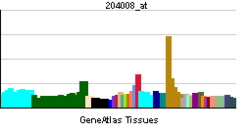- DNAL4
-
Dynein, axonemal, light chain 4 Identifiers Symbols DNAL4; PIG27 External IDs OMIM: 610565 MGI: 1859217 HomoloGene: 38094 GeneCards: DNAL4 Gene Gene Ontology Molecular function • microtubule motor activity
• microtubule motor activity
• ATPase activity, coupledCellular component • cytoplasm
• cytoskeleton
• axonemal dynein complex
• microtubule
• plasma membrane
• cilium
• cilium axonemeBiological process • microtubule-based movement
• nerve growth factor receptor signaling pathwaySources: Amigo / QuickGO RNA expression pattern 
More reference expression data Orthologs Species Human Mouse Entrez 10126 54152 Ensembl ENSG00000100246 ENSMUSG00000022420 UniProt O96015 Q9DCM4 RefSeq (mRNA) NM_005740 NM_017470.2 RefSeq (protein) NP_005731 NP_059498.2 Location (UCSC) Chr 22:
39.17 – 39.19 MbChr 15:
79.59 – 79.61 MbPubMed search [1] [2] Dynein light chain 4, axonemal is a protein that in humans is encoded by the DNAL4 gene.[1][2]
References
- ^ Dunham I, Shimizu N, Roe BA, Chissoe S, Hunt AR, Collins JE, Bruskiewich R, Beare DM et al. (Dec 1999). "The DNA sequence of human chromosome 22". Nature 402 (6761): 489–495. doi:10.1038/990031. PMID 10591208.
- ^ "Entrez Gene: DNAL4 dynein, axonemal, light chain 4". http://www.ncbi.nlm.nih.gov/sites/entrez?Db=gene&Cmd=ShowDetailView&TermToSearch=10126.
Further reading
- Rual JF, Venkatesan K, Hao T et al. (2005). "Towards a proteome-scale map of the human protein-protein interaction network". Nature 437 (7062): 1173–1178. doi:10.1038/nature04209. PMID 16189514.
- Gerhard DS, Wagner L, Feingold EA et al. (2004). "The status, quality, and expansion of the NIH full-length cDNA project: the Mammalian Gene Collection (MGC)". Genome Res. 14 (10B): 2121–2127. doi:10.1101/gr.2596504. PMC 528928. PMID 15489334. http://www.pubmedcentral.nih.gov/articlerender.fcgi?tool=pmcentrez&artid=528928.
- Collins JE, Wright CL, Edwards CA et al. (2005). "A genome annotation-driven approach to cloning the human ORFeome". Genome Biol. 5 (10): R84. doi:10.1186/gb-2004-5-10-r84. PMC 545604. PMID 15461802. http://www.pubmedcentral.nih.gov/articlerender.fcgi?tool=pmcentrez&artid=545604.
- Iwasaki M, Kuwata T, Yamazaki Y et al. (2005). "Identification of cooperative genes for NUP98-HOXA9 in myeloid leukemogenesis using a mouse model". Blood 105 (2): 784–793. doi:10.1182/blood-2004-04-1508. PMID 15454493.
- Collins JE, Goward ME, Cole CG et al. (2003). "Reevaluating human gene annotation: a second-generation analysis of chromosome 22". Genome Res. 13 (1): 27–36. doi:10.1101/gr.695703. PMC 430954. PMID 12529303. http://www.pubmedcentral.nih.gov/articlerender.fcgi?tool=pmcentrez&artid=430954.
- Strausberg RL, Feingold EA, Grouse LH et al. (2003). "Generation and initial analysis of more than 15,000 full-length human and mouse cDNA sequences". Proc. Natl. Acad. Sci. U.S.A. 99 (26): 16899–16903. doi:10.1073/pnas.242603899. PMC 139241. PMID 12477932. http://www.pubmedcentral.nih.gov/articlerender.fcgi?tool=pmcentrez&artid=139241.
- Suzuki Y, Yoshitomo-Nakagawa K, Maruyama K et al. (1997). "Construction and characterization of a full length-enriched and a 5'-end-enriched cDNA library". Gene 200 (1–2): 149–156. doi:10.1016/S0378-1119(97)00411-3. PMID 9373149.
- Maruyama K, Sugano S (1994). "Oligo-capping: a simple method to replace the cap structure of eukaryotic mRNAs with oligoribonucleotides". Gene 138 (1–2): 171–174. doi:10.1016/0378-1119(94)90802-8. PMID 8125298.
Categories:- Human proteins
- Chromosome 22 gene stubs
Wikimedia Foundation. 2010.
